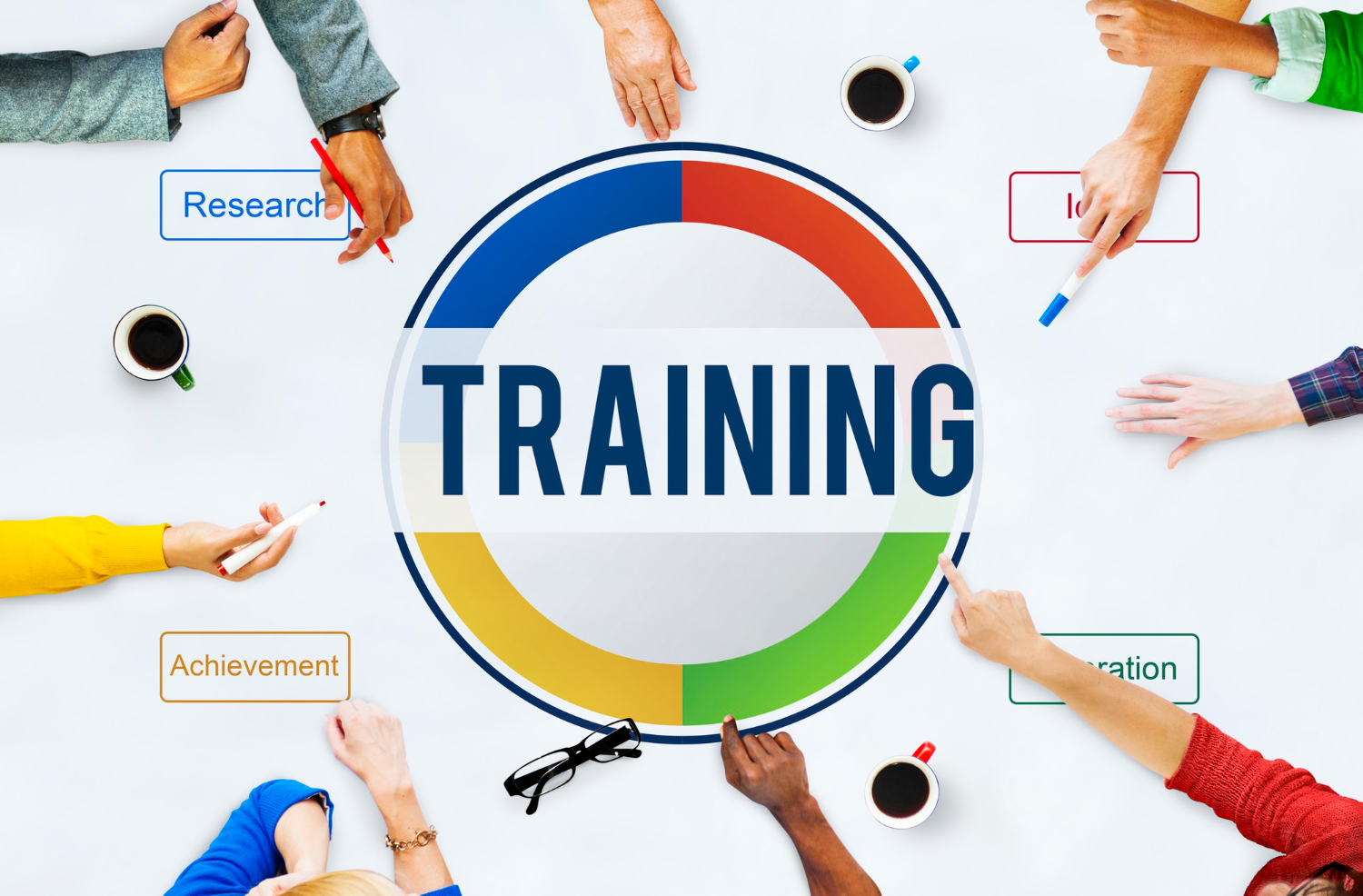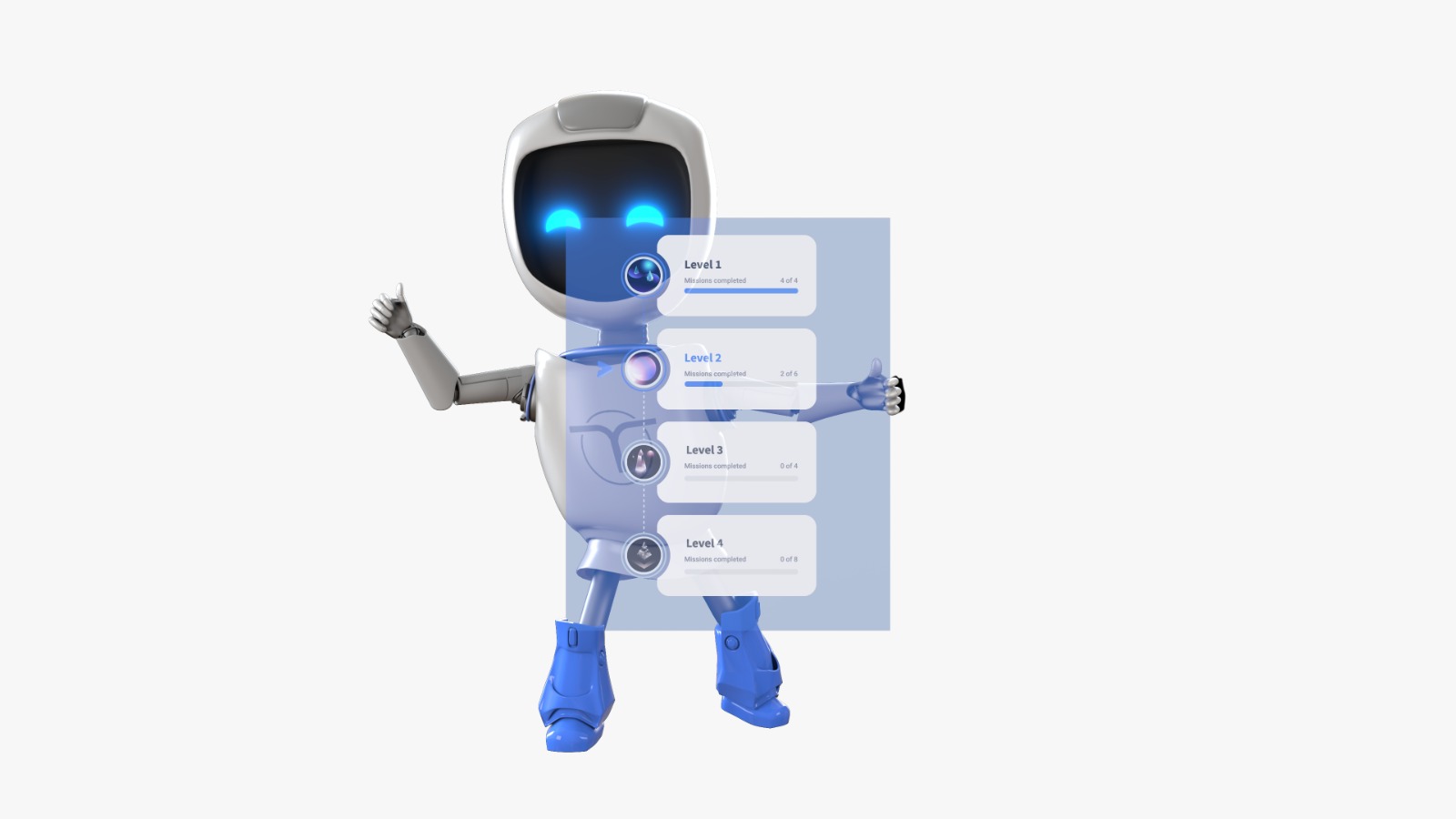In 2024, U.S. training expenditures accounted for $98 billion across different types of training for employees. Yes, it’s an investment, but one that pays off!
Training doesn’t just prepare your employees to work but it also gives them the right resources to grow personally and professionally. In fact, Forbes predicts that the top reason employees will leave their jobs in 2025 will be a lack of career growth opportunities. This highlights just how important learning and development (L&D) opportunities have become.
And training isn’t only beneficial to the people, but also to the organizations. A study by the Association for Talent Development (ASTD) found that companies in the top 25% for training investment had, on average:
- 24% higher profit margins
- 218% higher income per employee
- 26% better price-to-book ratios.
In this article, we explore each type of training for employees: from onboarding to leadership, and from soft skills to compliance.
Why Do You Need More Types of Training for Employees?
The workplace has evolved radically throughout the years. During the Industrial Revolution, in the 1800s, workers faced dangerous conditions, putting their health, safety, and even lives at risk. Many were children who worked long hours with no prior preparation, guidance or safeguards.
Fast forward 200 years, and thankfully, training has become a core part of protecting employees and businesses alike, a strategy that supports safety, productivity, and career development. The types of training for employees today reflect how far we’ve come since then.
Let’s break down why that variety matters.
Different Needs, Different Training
A new hire needs onboarding. An experienced professional might need leadership coaching. And then there are areas like compliance, product training, or technical upskilling that require ongoing updates, no matter how experienced someone is.
Each training type has its own purpose and timing, helping employees perform better.
Spacing Out and Reinforcement Lead to Higher Information Retention
There’s a reason why school lasts so many years. People can’t learn efficiently if it’s all crammed into a short period. According to research published in the Frontiers in Psychology journal, spacing learning over time leads to better retention and stronger generalization of skills in both adults and children.
Risk Management
Compliance, safety, data protection, anti-harassment, and diversity training are no longer optional but required by law. Skipping them exposes your business to massive financial and legal risks. Worse, it leaves employees vulnerable to unsafe practices.
Training = No Longer a Perk but a Priority
Salary matters, but today’s employees want more than just a paycheck. Benefits like healthcare, flexible work options, and learning opportunities weigh heavily on job decisions. For example, a LinkedIn survey reported by CNBC found that 94% of employees would stay at a company longer if it invested in their learning and development.
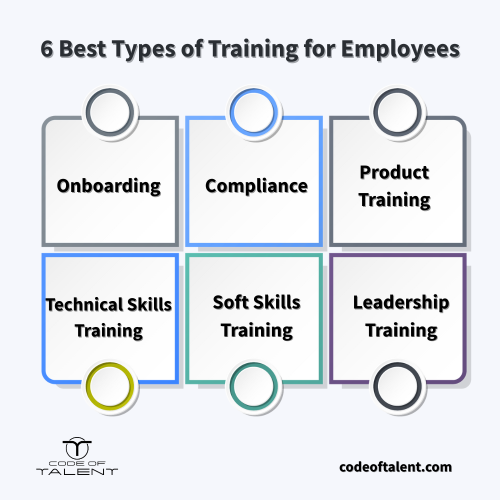
1. Onboarding Training
Onboarding is the induction training that every new employee goes through at the beginning of their journey with a company. Onboarding happens regardless of whether it’s their first job or they bring decades of experience. It’s usually the event that sets the tone for the employee’s relationship with the company. So, a weak onboarding experience can lead, in the worst case scenario, to turnover.
But when done right, the returns of onboarding are significant. According to The HR Digest, strong onboarding can improve new employee productivity by more than 70%. And 50% of companies with a formal onboarding process see greater new hire retention than those without.
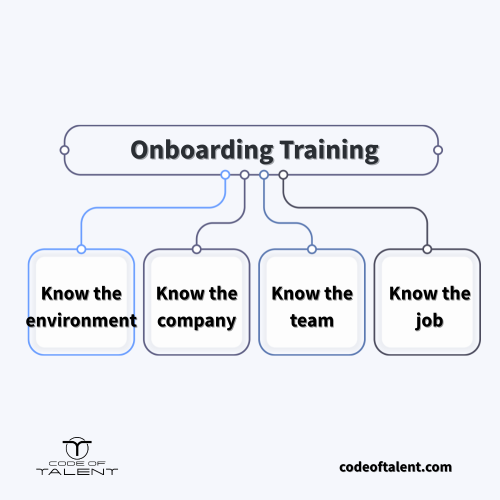
Effective onboarding covers:
Getting Used to the Environment
The very first thing a new employee does at a company is learn how things work—literally. This stage helps them feel physically grounded in their new environment, whether it’s a corporate office, factory floor, or fully remote setup. It often includes:
- Site tours
- Workstation setup
- IT onboarding
- Access credentials
- Learning the tools they’ll use every day.
Getting to Know the Company
Onboarding is where employees learn about the company’s values, organizational structure, and internal processes like:
- Requesting time off
- Submitting expenses
- Escalating concerns.
Most importantly, it helps new employees understand what makes this company unique and what’s expected of them beyond their job description.
Getting to Know the Team
Joining a new team is like stepping into a conversation that’s already been going on for a while. The faster new hires build trust with their manager, teammates, and even cross-functional colleagues, the better they’ll collaborate and contribute.
This part of onboarding includes:
- Team introductions
- Scheduled 1-on-1
- Department overviews
- Mentorship or buddy systems.
Getting to Know the Role
Even the most experienced hires need a warm-up period before starting a new job. It’s not that they don’t understand the role. It’s that a new position means getting used to new tools, tasks, goals, and workflows. This may include:
- Shadowing sessions
- Simulated exercises
- Job-specific training.
2. Compliance Training
Compliance training is a formal program that educates employees about the laws, regulations, and internal policies relevant to their role, industry, and organization. It’s usually mandated under local, national, and international laws, therefore it’s a priority during the onboarding process and reinforced at least 1-2 times per year.
Its purpose is to reduce legal and ethical risks for a safer and fairer workplace. Due to the complexity of compliance, several types of training fall under this label.
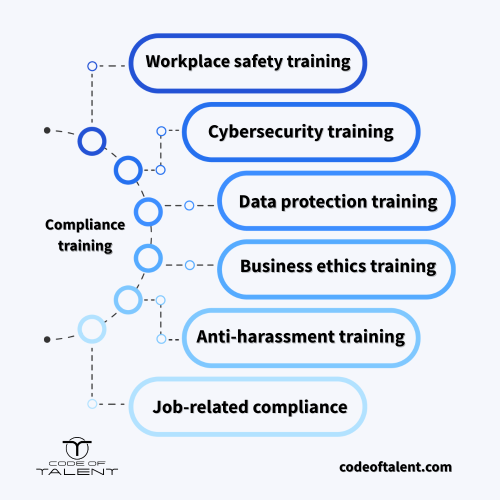
Workplace Safety Protocols
In 2023, the US Bureau of Labor Statistics reported 2.6 million nonfatal workplace injuries and illnesses from private industry employers, with healthcare and social assistance in the lead. Workplace safety training takes different forms across industries, but it’s vital in industries where physical risks are present, like manufacturing, construction, transportation, and healthcare. It covers procedures for:
- Operating machinery
- Handling hazardous materials
- Using personal protective equipment (PPE)
- First aid.
In office-based roles, safety might focus more on ergonomic practices, fire drills, and workplace injury prevention.
Cybersecurity
Cybersecurity training educates employees on threats such as:
- Phishing attacks
- Weak passwords
- Social engineering.
Essential in tech, finance, and healthcare, this training helps prevent data breaches, financial losses, and reputational damage. Even in small companies, cybersecurity is a non-negotiable part of compliance, as every employee with a login is vulnerable to scams. According to Deloitte’s X-Force 2025 Threat Intelligence Index, although successful phishing attacks are down 50% since 2022, phishing emails with info-stealing malware have jumped 84%.
GDPR and Data Protection
For organizations operating in or serving clients in the EU, GDPR (General Data Protection Regulation) compliance is critical. For reference, as of February 2025, GDPR fines have reached a total of €5.6 billion across 2,295 violations.
Employees must be trained on:
- How to handle personal data
- What can be collected
- How long it can be stored
- When consent is required.
Similar rules apply under different names in other regions (like CCPA in California), and industries like media, finance, healthcare, and e-commerce are especially affected.
Business Ethics
Ethics training promotes integrity, transparency, and accountability in the workplace. According to an article by Investopedia, following ethical guidelines improves trust, productivity, and reputation. It also attracts and retains talent, as employees tend to reflect management’s ethical standards. This training is key in industries such as finance, legal, consulting, and government contracting, where ethical mistakes can lead to serious legal and reputational consequences.
Employees learn about:
- Conflicts of interest
- Anti-corruption laws
- Bribery
- Proper conduct with clients or public officials.
Anti-Harassment and Discrimination Training
According to a 2023 survey, 41% of employees experienced or witnessed inappropriate behaviors in the workplace, highlighting that harassment and discrimination remain significant issues in today’s work environment. This type of training helps employees recognize and prevent workplace harassment, bullying, and discrimination based on race, gender, age, disability, religion, or sexual orientation.
It’s especially important in diverse, global organizations and is required by law in many countries and U.S. states. The training typically includes:
- Real-life scenarios
- Reporting procedures
- Bystander intervention strategies.
Job-Related Compliance Training
Each industry has its own set of rules and regulations to follow, according to their exposure to risks. This training is usually regulated by federal or regional authorities and often renewed annually.
Some examples include:
- HIPAA regulations training for healthcare professionals
- Anti-money laundering (AML) and US Securities and Exchange Commission compliance for finance employees
- Food safety and hygiene standards for food industry workers
3. Product Training
There would be no business without a product or service to sell. A well-designed product is the backbone of any successful business venture. Understanding its various aspects is crucial, not just for the teams that build and manage it, but also for employees in departments that may not interact with it directly, such as HR or accounting.
Product training is one of the most essential types of training for employees. It provides a deep understanding of how the product works, its values, and how to communicate or use it. This training isn’t limited to internal teams; it’s also essential for external audiences like clients, vendors, and partners.
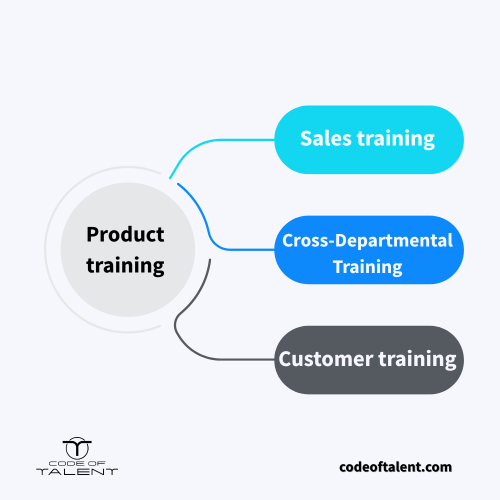
Sales Training
Product training for sales teams goes beyond surface-level features. Sales reps must understand benefits, use cases, and most importantly, how the product solves customers’ main pain points. According to Forbes, 73% of customers say that having strong product knowledge is the most important quality they look for in a sales associate.
This training often includes:
- Competitor analysis
- Value propositions
- Demo scripts
- Objection handling
- Closing techniques.
In terms of industry specifics, in tech for example, sales reps might receive technical onboarding for software-as-a-service (SaaS) platforms, while in B2C industries such as retail, the focus could be on product lines, pricing strategies, and upselling techniques.
Cross-Departmental Training
All departments in a company should understand at least the fundamentals of the product, as it directly impacts their work. Teams like marketing, customer support, design, and even HR rely on product insights to communicate and represent the brand accurately. For example, marketing teams use product knowledge to craft campaigns that highlight key features or address customer pain points.
Ultimately, cross-functional product training ensures that all departments speak the same language about the product.
Customer Training
For some companies, especially those in tech or manufacturing, training doesn’t stop with employees. Customer training helps users understand the product better, which leads to fewer support tickets and higher overall satisfaction with both the service and the brand.
This type of training can take many forms, including:
- Onboarding webinars
- Interactive tutorials
- In-app guidance
- User manuals
- Full certification programs.
One of the best examples comes from Apple, which runs in-store workshops specifically for the elderly. This approach helps people familiarize with new technology, while Apple gains a new segment of loyal customers.
4. Technical Skills Training
Technical skills training often has the reputation for being theory-heavy or even “boring”. But it’s now more important than ever, as AI takes over jobs and people need to reskill. According to a recent McKinsey Global Survey, nearly 90% of executives and managers say their organizations are already facing skill gaps or expect to within the next five years.
Usually delivered by subject matter experts rather than L&D teams, this type of training equips employees with the specific tools, systems, and techniques their roles require. Technical skill needs vary widely by industry: what a software engineer requires differs greatly from a lab technician or machine operator. That’s why this type of training must be regularly updated and engaging enough for employees to retain information easily.
Below are some examples of technical skills training per industry:
Healthcare
- Electronic Health Records (EHR) systems training (e.g., Epic, Cerner)
- Medical device operation (e.g., MRI, ultrasound machines)
- Telehealth software usage for remote consultations
- Clinical decision support system (CDSS) use
Telecommunications
- Network configuration and troubleshooting (e.g., routers, fiber optics)
- 5G technology deployment and maintenance training
- VoIP system setup and support (e.g., Cisco, Avaya)
- Troubleshooting broadband and mobile networks
Banking and Finance
- Core banking software training (e.g., Finacle, Temenos)
- Risk management systems and fraud detection tools usage
- Regulatory compliance platforms (AML, KYC tools)
- Digital payment systems (e.g., POS, mobile banking apps)
Pharma
- Laboratory information management systems (LIMS) training
- Good Manufacturing Practice (GMP) compliance systems
- Clinical trial management software (CTMS) training
- Pharmacovigilance reporting tools (e.g., Argus Safety)
- Product lifecycle management (PLM) systems training
Retail
- Point-of-Sale (POS) system operation and troubleshooting
- Inventory management software (e.g., SAP, Oracle Retail)
- E-commerce platform management (e.g., Shopify, Magento)
- Customer loyalty program systems handling
- Visual merchandising digital tools (planograms, retail analytics)
Fast-Moving Consumer Goods (FMCG)
- Customer Relationship Management (CRM) software training (e.g., Salesforce, Zoho)
- Mobile order-taking and sales apps (e.g., Repsly, Pepperi)
- Data-driven market analysis tools (e.g., NielsenIQ, SPINS)
- Sales force automation (SFA) system usage
- Digital planogram compliance tools for merchandising teams
Logistics and Courier Services
- Logistics Management Systems (LMS) training (e.g., Manhattan Associates, SAP EWM)
- Route optimization apps (e.g., Routific, Onfleet)
- Barcode scanning and inventory tracking tools
- Warehouse automation systems (robotics, conveyor belts)
Call Centers
- Call handling and ticketing systems (e.g., Zendesk, Freshdesk)
- Customer Relationship Management (CRM) tools (e.g., HubSpot, Salesforce)
- Interactive Voice Response (IVR) system operation
- Knowledge base management systems
- Quality monitoring and analytics software (e.g., NICE, Verint)
5. Soft Skills Training
The “fun part” of corporate training, soft skills training differs significantly from technical skills training, as it’s much harder to change behavior than teaching predefined theories or frameworks. People bring with them biases, past experiences, fears, talents, quirks, and personal values, making behavioral change a complex challenge for L&D professionals. Moreover, according to the National Soft Skills Association, a person’s emotional intelligence (EQ) is the foundation for effectively learning soft skills. Without it, the ability to understand and apply these skills is limited.
Despite these challenges, the benefits of soft skills training are substantial. Incorporating it into the various types of training for employees helps improve collaboration, job satisfaction, and overall organizational performance.

Here are some examples of soft skills to teach in the workplace:
- Communication: Clear written, verbal, and nonverbal communication is key in every industry. Training covers public speaking, email etiquette, and active listening.
- Emotional Intelligence: EQ helps employees navigate workplace relationships with empathy, self-awareness, and emotional control.
- Teamwork and Collaboration: Training here promotes shared goals, accountability, and respect for diverse perspectives.
- Problem-Solving and Critical Thinking: Employees need to analyze issues and make decisions, whether solving IT bugs or supply chain hiccups. Training may include scenario planning or design thinking.
- Adaptability and Flexibility: With fast-changing industries, employees must embrace change and new methods. Training builds resilience and openness.
- Customer Service Excellence: Great service can set a business apart. A global analysis data found that 25 countries, representing 78% of global household consumption, face $3.7 trillion in sales at risk in 2024 due to poor customer experiences. This training focuses on empathy, conflict resolution, and communication skills.
- Time Management and Productivity: Staying organized and focused improves performance. Training in this area might include prioritization frameworks, digital productivity tools, or techniques for minimizing distractions.
6. Leadership Training
According to LinkedIn’s 2025 Workplace Learning Report, leadership training is the number one focus area in career development, taking up 71% of learning initiatives. The demand for well-prepared leaders—those with both technical expertise and EQ—has grown significantly, as employees value the quality of their relationship and interactions with their managers. In fact, toxic managers are one of the top reasons employees leave, outweighing factors like salary or workload.
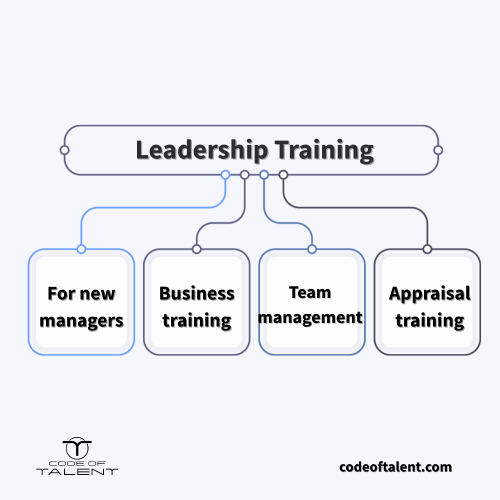
Training targeted for managers cover:
- Leadership Training for New Managers: The most important training a manager should go through for their initiation into the new role. This training helps new managers shift their mindset, learn how to delegate, give feedback, and motivate others right from the start.
- Management and Business Training for Leaders: Managers are a buffer between their team and upper management, so it’s essential for them to understand core business functions. Training includes strategy, budgeting, operations, and interpreting performance metrics.
- Team Management Skills: Managing people requires more than technical know-how. Training here covers setting goals, resolving team conflicts, coaching for performance, and navigating interpersonal dynamics.
- Appraisal and Performance Review Training for Managers: Performance reviews are one of a manager’s core responsibilities that can make or break their image. Promote the wrong person, and their credibility takes a hit; overlook high performers, and turnover may rise. This training focuses on how to conduct fair, constructive appraisals and give feedback that motivates rather than discourages.
All Types of Training for Employees into One Holistic Program
With so many types of training for employees available today, it’s easy for both employees and facilitators to feel overwhelmed. Which ones should you prioritize? Which can you streamline or integrate? The good news is you don’t have to choose.
Code of Talent brings together all kinds of employee training into one flexible, AI-powered platform. Whether it’s onboarding, product training, compliance, or upskilling, it turns complex learning paths into engaging experiences. The platform combines microlearning, gamification, AI optimization, collaborative tools, and data-driven insights into a single solution.
Here’s how it works
Step 1: Enter your company name and select the training type. Code of Talent offers a variety of options to choose from, including onboarding, product training, sales training, upskilling, and compliance.
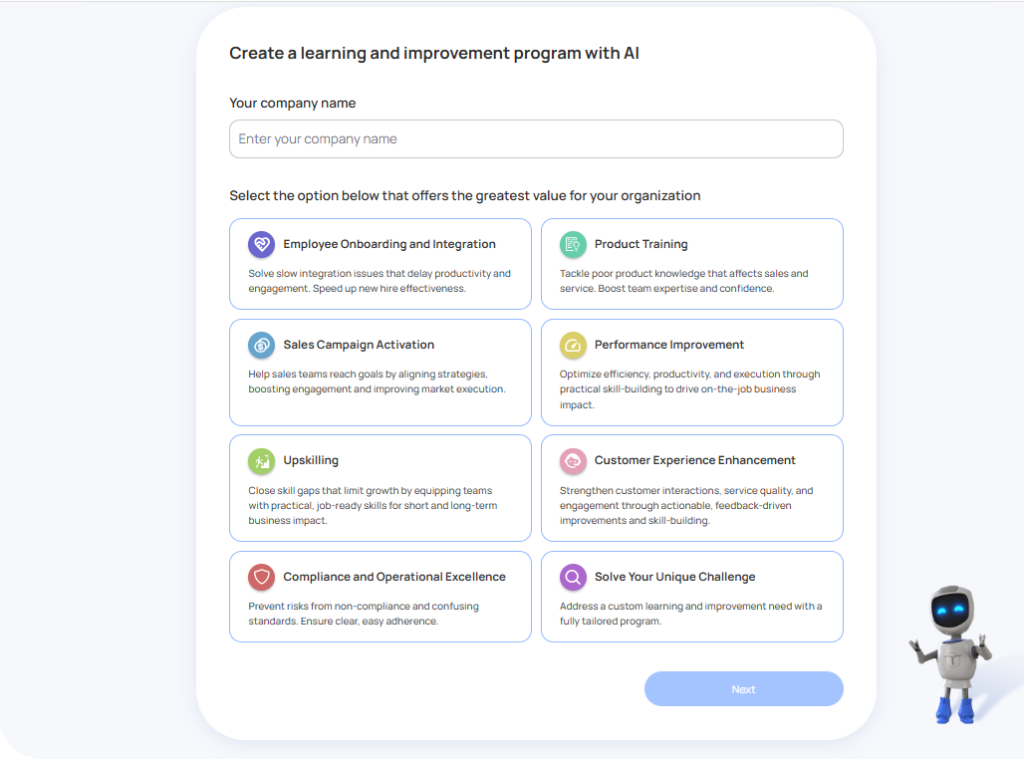
Step 2: Upload any relevant documentation (HR policies, product manuals, legal guidelines). If you don’t have any, you can skip this step. AI can still generate custom content based on your inputs.
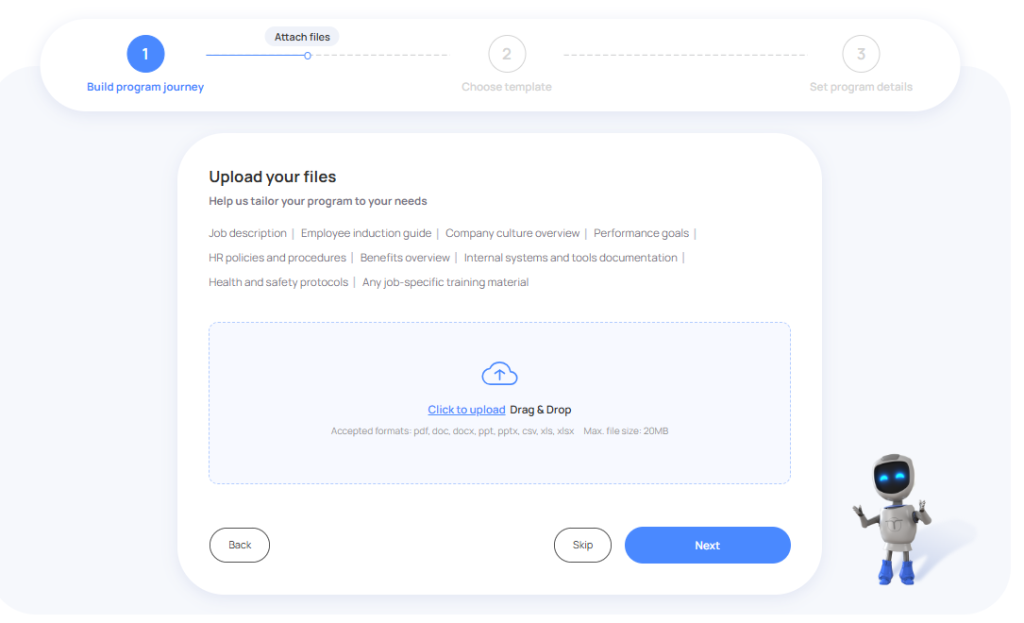
Step 3: Answer four short questions. Based on your responses, Code of Talent’s AI builds tailored programs aligned with business goals and team roles. Not sure how to answer? AI will suggest options.
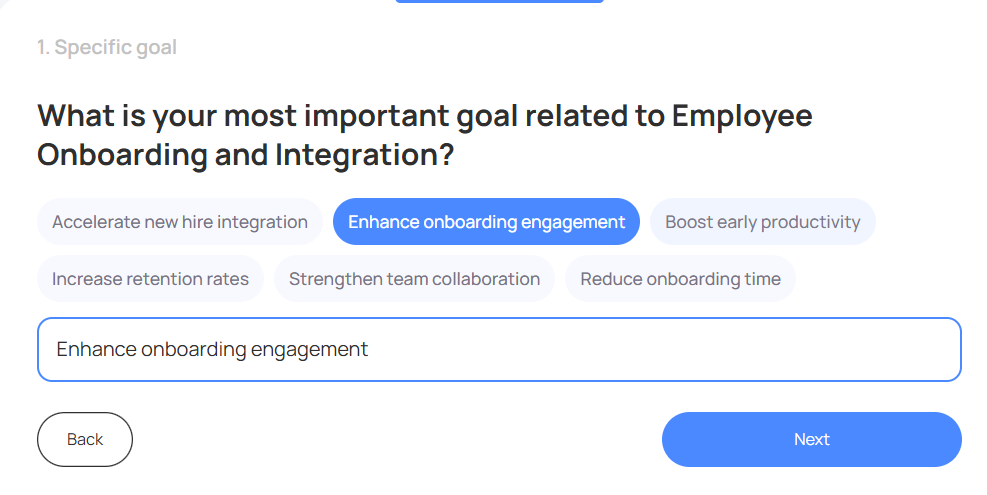
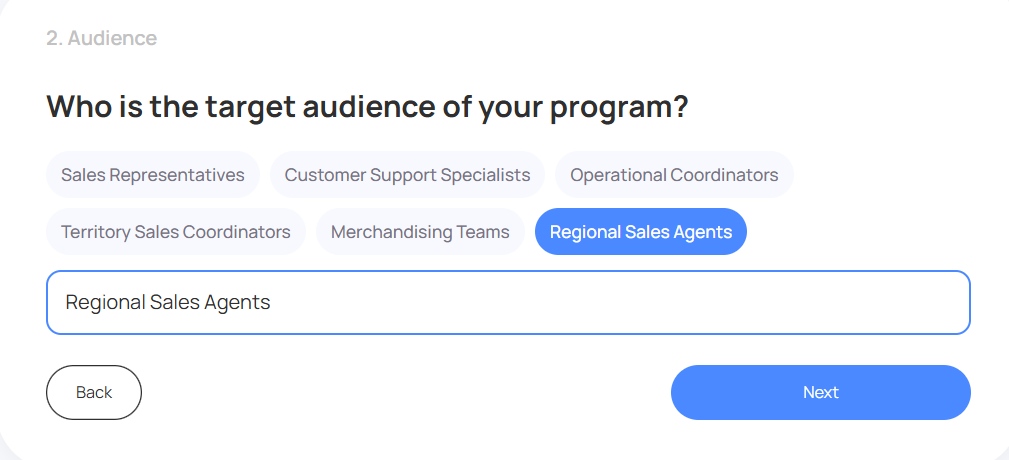
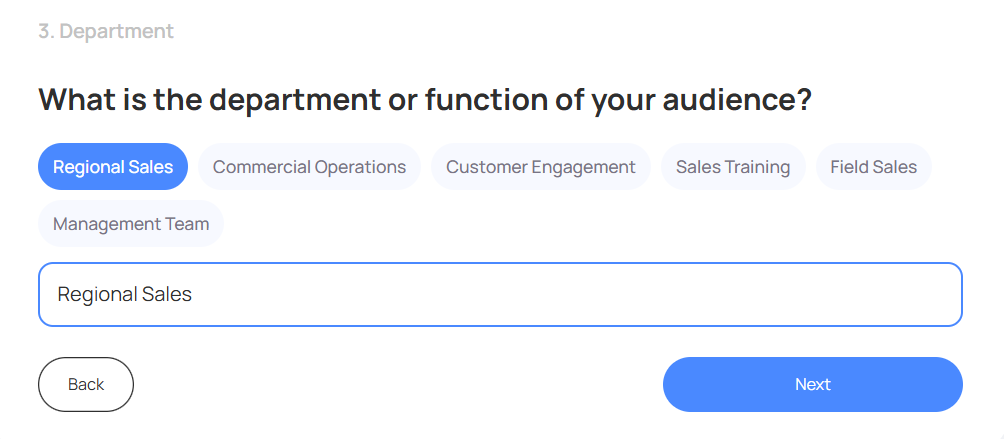

Step 4: Customize the generated missions by editing text, uploading images, and adjusting formats to match your brand.
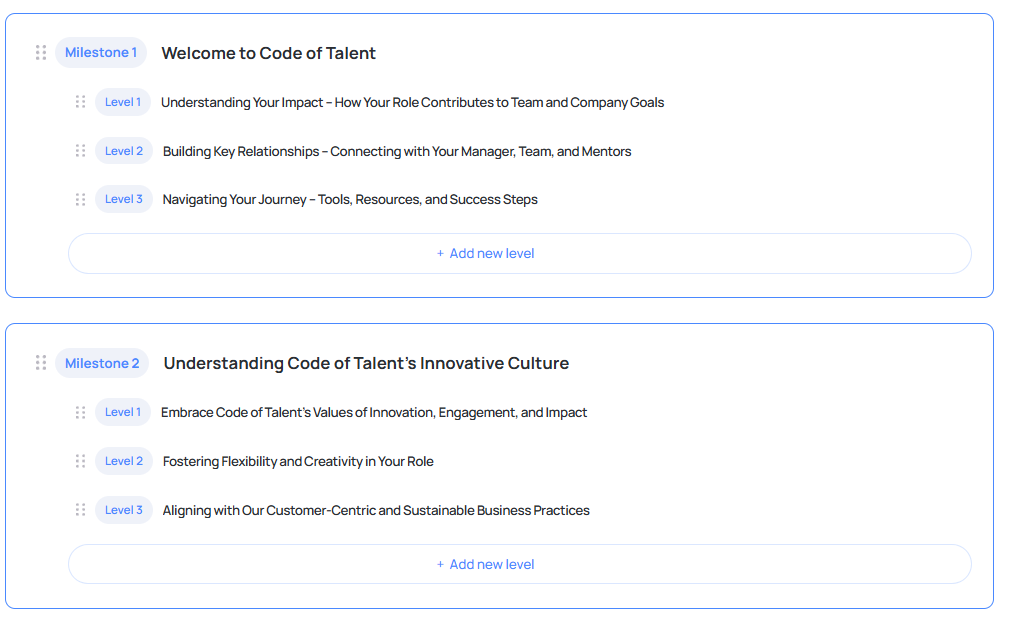
Step 5: After editing, AI will generate the final training draft. Here’s an example of the first missions in an onboarding program for Code of Talent employees.
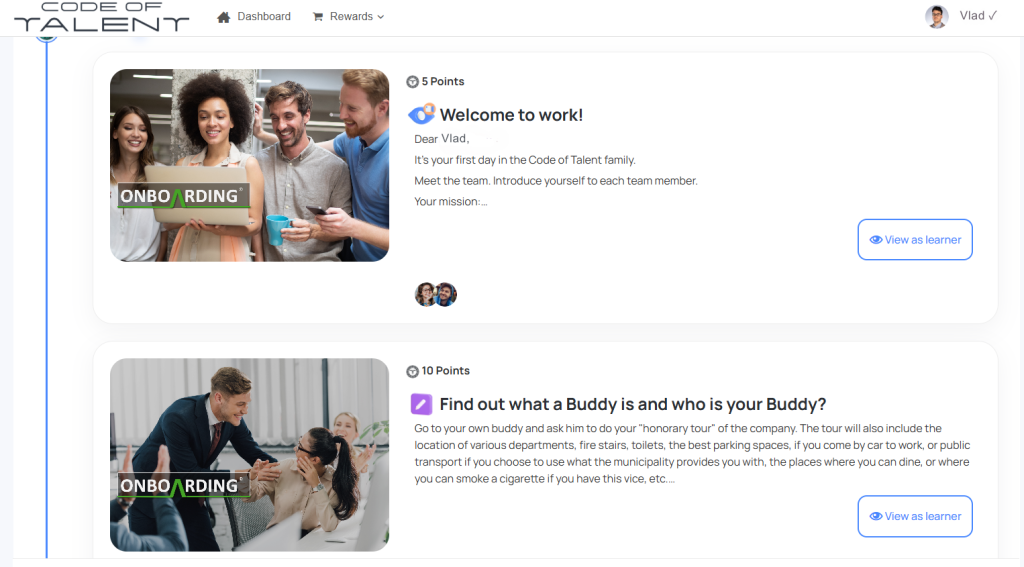
Step 6: Deploy the training to your team. Choose from multiple delivery options to suit remote, hybrid, or in-person teams.
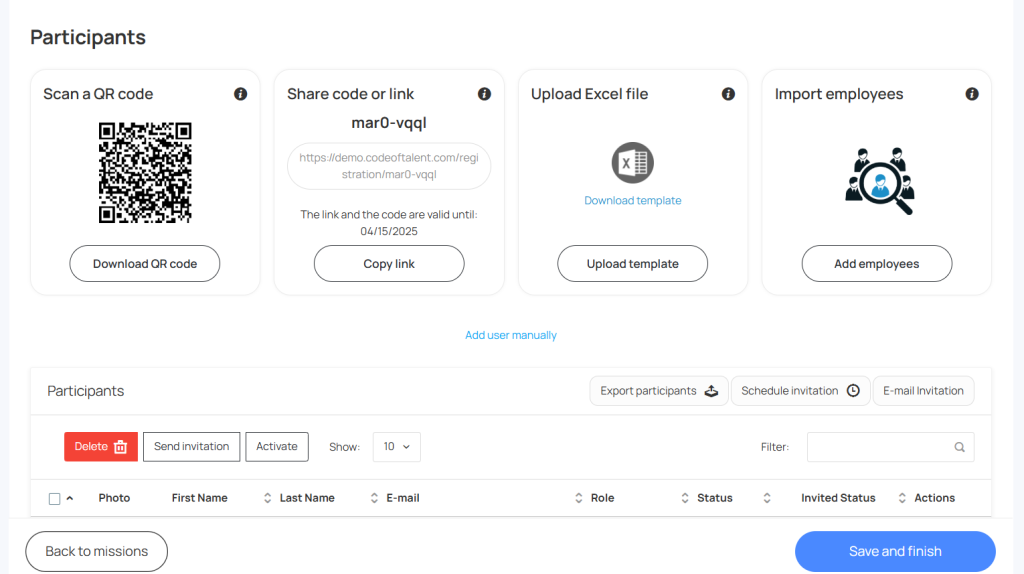
Conclusion
When training is scattered across multiple tools, it becomes harder to manage, scale, and make an impact. With Code of Talent, you bring it all together: onboarding that accelerates productivity from day one, compliance that protects your company, leadership that drives strategic thinking, and reskilling that keeps your team ready for every challenge.
Try Code of Talent’s free trial today and test all types of training for employees out there. Go to “Try for Free” and select the training type you want to explore. Everything you need is in one place, built to work together!

